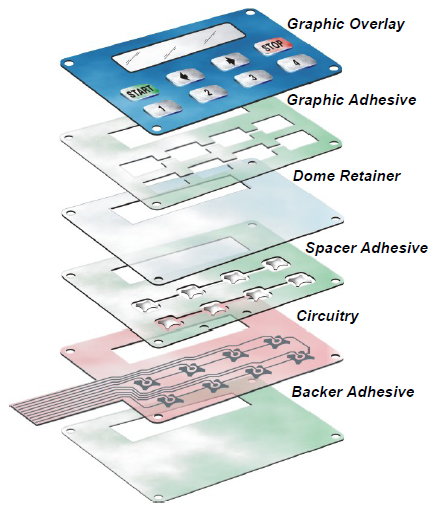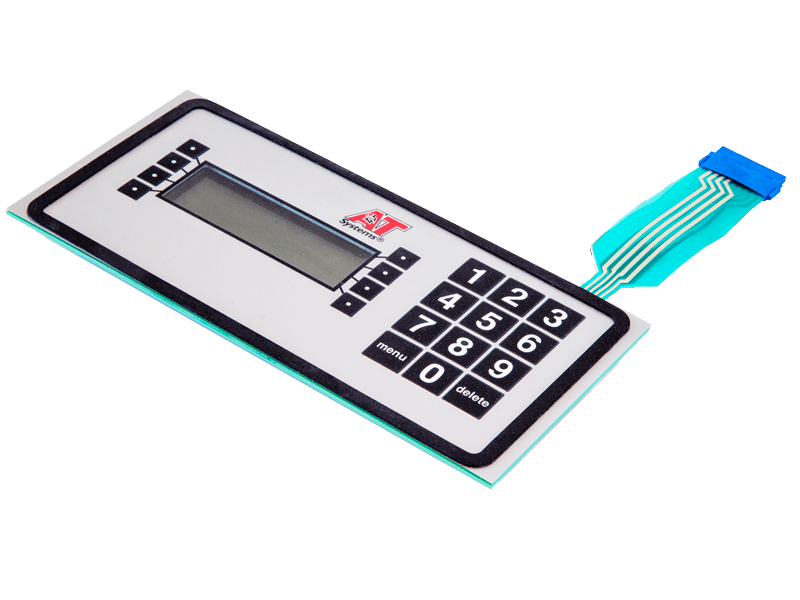You’ll see the difference when collaborating with a top-tier membrane switch manufacturer.
You’ll see the difference when collaborating with a top-tier membrane switch manufacturer.
Blog Article
What to Try to find When Choosing a Membrane Switch for Your Project
When you're selecting a membrane layer button for your task, several crucial aspects come right into play. You'll require to believe about the products, design, and exactly how well it straightens with your brand name.
Comprehending Membrane Switch Over Parts
When you plunge into the world of membrane switches, it's important to understand the crucial components that make them function. The switch typically contains 3 major layers: the graphic overlay, the spacer layer, and the circuit layer. The visuals overlay gives the aesthetic interface, displaying switches and symbols you require for simple navigating. Below that, the spacer layer guarantees there suffices range in between the circuit and the overlay, permitting the switch to turn on without continuous pressure.
Understanding just how these layers work with each other helps you pick a membrane button that's reliable and fits your job needs. Pay close focus to the density and material of each layer, as these aspects affect resilience and performance in different environments.
Product Choice and Its Effect
Selecting the ideal materials for your membrane switch can greatly influence its efficiency and longevity. The choice of substratum, generally polyester or polycarbonate, affects resilience and adaptability. Polyester is more abrasion-resistant, while polycarbonate uses much better clearness and stamina.
Next, think about the adhesive. It requires to stand up to ecological aspects like moisture and temperature changes. A solid adhesive warranties that your membrane button stays undamaged with time.
Don't forget the visuals overlay. The printing technique used, whether silkscreen or digital, affects the button's aesthetics and durability. High-grade inks will withstand fading and scratching, preserving a professional appearance.
Last but not least, think of environmental problems. If your device will certainly be revealed to harsh chemicals or extreme temperatures, pick materials made to endure these difficulties. Your choices in products will ultimately determine the button's integrity and individual fulfillment.
Style Considerations for Individual Experience
Picking the ideal materials lays the foundation for a successful membrane layer switch, however the style likewise plays a significant role in user experience. You'll intend to assess just how the format affects functionality (membrane switch manufacturer). Maintain switches and symbols intuitive and well-spaced, making it very easy for customers to navigate without complication

Shade and contrast are also essential; assurance that your style is visually enticing however still practical. High comparison helps customers easily determine buttons, especially in low-light problems.
Last but not least, show on the general visual. A sleek and modern-day style can raise user perception and make your product more attractive. Balancing functionality with an interesting style will certainly lead to a better individual experience and eventually, a more successful item.

Environmental Factors and Resilience
When selecting a membrane switch, you require to take into consideration how it'll perform in different atmospheres. Elements like temperature resistance, dampness and chemical direct exposure, and mechanical wear can substantially impact its toughness. Comprehending these components will aid you pick a button that withstands your specific problems.
Temperature Resistance Requirements
As ecological problems can differ commonly, recognizing temperature level resistance is important for making certain the sturdiness of your membrane button. Make sure to examine the specifications of the materials utilized in the button, like the adhesive and overlay, as they directly influence efficiency. By choosing a membrane layer switch with appropriate temperature resistance, you'll boost its lifespan and preserve performance in tough environments.

Dampness and Chemical Direct Exposure
Moisture and chemical direct exposure can considerably affect the performance and long life of your membrane layer button, so it's essential to recognize the setting in which it will certainly be utilized. If your task involves high humidity or exposure to fluids, try to find safety coatings and sealers that can improve resistance to dampness. In addition, take into consideration the types of chemicals your button may experience. Certain products can break down when subjected to solvents, oils, or harsh cleansers. Choosing the appropriate materials, like polycarbonate or polyester, can aid withstand these components. Constantly get in touch with the producer's specs for chemical compatibility to assure your membrane layer button maintains its functionality with time. By prioritizing wetness and chemical resistance, you can improve the sturdiness of your switch in tough settings.
Mechanical Damage
While you might focus on functions like appearances and functionality in your membrane layer button, mechanical damage can significantly influence its performance with time. Consider how commonly the switch will certainly be used and the environment it'll remain in. Constant pressing can result in destruction of products, triggering issues like tactile feedback loss or also change failure. Seek versions with robust styles, such as those with safety overlays that resist scratches and use. Furthermore, look for specs on cycle life, which suggests the number of presses the button can handle prior to revealing indicators of wear. Selecting a sturdy button warranties longevity and reliability, stopping pricey replacements and downtime in your project. Always aspect in sturdiness alongside looks and performance for peak efficiency.
Modification Options for Branding
When it pertains to branding your membrane layer button, personalization choices are crucial. You can pick layout aspects and shades that reflect your brand, along with details logo design positioning and dimension to improve exposure. Furthermore, selecting the appropriate products and structures can boost the general look, making your product stand out.
Style Components and Shades
A broad array of design components and colors can make your membrane layer button not simply practical however likewise visually attractive, boosting your brand identification. Don't neglect regarding textures; adding a responsive element can improve user experience and make your switch stand out. By attentively choosing style aspects and shades, you not only develop a product that looks great but also strengthens your branding constantly and efficiently.
Logo Placement and Dimension
After settling your layout elements and colors, the next step is to concentrate on logo design positioning and size. Your logo design is an important facet of your branding, so you'll want it to stand apart without frustrating other design aspects. Assess where your logo will be most visible and impactful; usual positionings consist of the leading or facility of the button.
Consider the size too-- too huge and it may outweigh functional elements, too tiny and it could get shed. Aim for an equilibrium that allows your logo to be easily identifiable while keeping my sources the total appearances. Don't fail to remember to ponder just how the logo design aligns with individual interaction. This attention to information will enhance both capability and brand identity in your job.
Material and Appearance Choices
Selecting the right materials and textures for your membrane layer button can greatly improve both its functionality and visual allure. You'll wish to assess choices like polyester or polycarbonate, as they supply sturdiness and resistance to put on. The structure of the surface likewise plays an important function; smooth coatings give a streamlined appearance, while textured surface areas can enhance grip and responsive comments.
Tailoring the products and textures permits you to reflect your brand name identification effectively. For instance, you may select a matte coating to communicate sophistication or a glossy look for a modern touch - membrane switch manufacturer. Don't forget color options, as vivid colors can make your switch stand out, while soft tones can produce a much more classy look
Price vs. Quality: Locating the Right Balance
When you're managing the choices for membrane layer buttons, balancing expense and top quality can really feel overwhelming. You intend to ensure that you're getting a trusted item without breaking the bank. Start by recognizing your project's specific requirements. Are you focusing on sturdiness or visual appeals? A lower-cost button may conserve you money upfront, yet if it endangers capability, you could deal with higher replacement expenses later on.
Look for producers that use a good mix of affordability and high criteria. Research their track record and consumer testimonials to assess dependability. Occasionally, investing a bit more in quality materials can save you from future migraines.
Likewise, take into consideration the long-term performance and service warranty alternatives. A a little extra expensive button with a solid guarantee could confirm to be a smarter investment. Ultimately, it's about discovering that pleasant spot where you satisfy your budget while assuring your job's success.
Testing and Top Quality Guarantee Protocols
While you may locate the perfect membrane switch style, assuring its top quality via extensive screening procedures is vital for long-lasting success. Start by verifying that the supplier follows market criteria, such as IPC/WHMA-A -620, to ensure a reliable item. membrane switch click for more info manufacturer. You'll want to check for extensive testing approaches, including environmental, mechanical, and electric analyses
Make specific the switches go through resilience screening, simulating real-world usage to recognize any kind of potential failings. Take notice of the manufacturer's quality control process, which must consist of routine examinations and audits.

Do not forget to ask for examples and perform your own tests to validate compatibility with your task. Take into consideration just how usually the manufacturer updates their procedures; advancement in testing can lead to improved quality. By prioritizing these screening and top quality assurance protocols, you'll increase the possibility of a successful and resilient membrane switch for your application.
Regularly Asked Questions
Exactly how Long Does a Membrane Layer Switch Over Typically Last?
A membrane layer button normally lasts anywhere from 1 to 10 million cycles, depending upon usage and environmental variables. You'll intend to consider your particular needs to ensure it fulfills your longevity demands effectively.
Can Membrane Changes Be Fixed if Damaged?
Yes, you can in some cases repair membrane layer buttons if they're harmed, yet it frequently depends on the degree of the damages. Minor concerns might be fixable, while more significant damage generally requires replacement for correct performance.
What Are the Common Applications for Membrane Switches?
Membrane layer buttons are commonly used in home appliances, medical gadgets, and automobile controls. You'll locate them in customer electronic devices, link commercial devices, and even video gaming consoles. Their adaptability makes them excellent for various interface and atmospheres.
Are There Particular Qualifications for Membrane Buttons?
Yes, there are particular qualifications for membrane switches. Try to find UL, CE, and RoHS accreditations to guarantee security and conformity. These certifications suggest the button meets market requirements for quality and environmental security.
Exactly how Do I Ensure Proper Installment of a Membrane Layer Switch Over?
To ensure correct installation of a membrane layer button, tidy the surface area thoroughly, align it very carefully, and apply even pressure. Comply with maker standards for adhesive curing time to optimize sturdiness and capability.
Verdict
When selecting a membrane layer button for your task, keep these essential aspects in mind: focus on long lasting products, focus on user-friendly layout, and take into consideration personalization for your brand name. By very carefully reviewing these elements, you'll guarantee your membrane layer switch not just fulfills your task needs yet also improves user experience and reflects your brand identification successfully.
Report this page